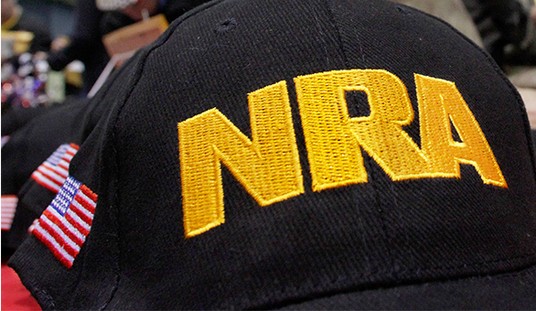In the New York Times, Richard Fausset’s prose leaks with sympathy for the mother of Zaevion Dobson, the Tennessee teenager killed while attempting to shield two girls caught up in a gang-relating shooting.
Wade through it, and you find the sort of tepid and misdirected anger that seems to permeate so much of the paper’s writing about violence, which it consistently blames on tools, instead of violent people.
Zenobia Dobson removed the envelope from her mailbox and placed it, unopened, in her apartment in the Lonsdale Homes public housing complex, her living room already crowded with artifacts of mourning, respect and unrecoverable loss.
There were the football jerseys, framed but not yet hung on the walls, in honor of her dead son. Proclamations from the city and county. A large painting of his face in the clouds. His weight bench, still by the front door.
There was also a collage, produced for his funeral, that included a reproduction of the Twitter message from President Obama that made her son Zaevion posthumously famous. It declared him “a hero at 15,” and asked, “What’s our excuse for not acting?” on gun control legislation.
Ms. Dobson ran some errands and then came home and opened the envelope. It was full of poems from University of Tennessee students she had never met, and their professor, the poet Marilyn Kallet, who wrote:
I want to kill the bullet that
Killed your son, Zenobia.
Want to stop this madness.Ms. Dobson read the poems, and then she cried as if it were still Dec. 17. That evening last year, Zaevion, the youngest of her three sons and a promising high school football player, was shot in the chest a couple of blocks from home in what the police say was a retaliatory gang attack. Zaevion, the police said, was an innocent bystander with no gang affiliation. He died shielding two young women from the attackers.
On Jan. 5, a few days after the president’s Twitter post, Mr. Obama mentioned Zaevion again in a tearful speech in which he proposed more vigorous gun-control legislation. The killing of this innocent teenager, he said, should allay any doubt “as to why you should feel that fierce urgency of now.”
But that was not the feeling in Knoxville, the third-largest city in a state where there has been little political appetite for a new gun-control crusade.
The Republican-controlled legislature here is one of the most gun-friendly in the nation. In February, it passed a resolution naming a semiautomatic weapon, the Barrett Model M82/M107, as the official state rifle. On Monday, Gov. Bill Haslam, a Republican, allowed a bill to become law that will allow faculty and staff members at public colleges and universities to be armed.
The mayor of Knoxville, Madeline Rogero, a Democrat in a city with a strong Republican presence, has decided that Zaevion’s story would best serve as an argument for strengthening programs for at-risk youth, and addressing the root causes of gang violence.
In an interview, Ms. Rogero, with what seemed like a mix of pride and exasperation, noted that she had been named as a defendant in two lawsuits challenging a city policy that banned firearms at the annual Tennessee Valley Fair. The National Rifle Association opposes the policy.
“When you make it just about guns, then you don’t really get more to the root cause of why somebody takes up a gun,” she said.
The police chief, David Rausch, who joined the mayor for an interview at City Hall, agreed that it would be tricky to make the teenager’s death a gun issue. “Because then you polarize people,” he said.
And so, with guns off the table, the response to the killing in this city of 184,000 has played out instead with a focus on themes that do not polarize in the American heartland: a respect for chivalry, sacrifice, football and mothers who resolve to raise good sons.
Fausset does the bidding of his masters, and continues the Times editorial history of lamenting the natural human right to bear arms in self defense which still exists (and in many cases, is expanding) in most of the “free states” south and west of the garbage-filled Hudson River.
Like other writers in the Times stable, Fausset does not mention the strong likelihood that Dobson’s murderers were prohibited persons who could not legally purchase nor possess a firearm. He pointedly glosses over the fact that the gang-affiliated killers who killed Dobson during an attempt to gun down other violent gang members almost certainly obtained their firearms illegally.
Admitting either reality would point out the utter futility of the prohibitive gun control laws favored by the editors of the Times.
Somber reflection examining the facts of Dobson’s murder, or the round-the-clock violence in Chicago, Detroit, New Orleans, Memphis, and dozens of other cities, would reveal something that the Times cannot bare to mention: the tools used commit these crimes vary from firearms, to knives, to impact and personal weapons like hands and feet… and the tools of violence are not remotely close to being the real problem.
What is the real problem?
The tools used to commit the violence—whether guns or knives or bats or fists—are ultimately irrelevant. For that matter, violence itself is a merely a tool.
It’s the cultural tendency of certain populations to glorify and misuse the tool of violence that is the real problem.
A prefect example of this violent culture just surfaced during a videotaped news report in New Orleans.
The reliably left-leaning Times and other news outlets consistently refuse to admit that we have a cultural problem.
The Times doesn’t want to admit we have a people problem.
They want to pretend we have a tool problem.
Why?








Join the conversation as a VIP Member